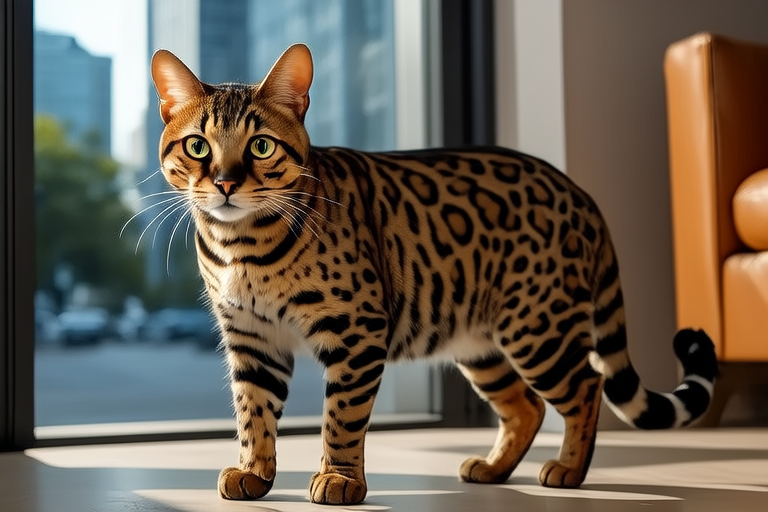Bengal Cats: The Wild at Heart Companion for Urban Living
Introduction
The Bengal cat, with its striking appearance and wild ancestry, has captured the hearts of many cat enthusiasts. These felines are not only beautiful but also incredibly energetic and playful, making them perfect companions for those living in urban environments. This article delves into the origins, characteristics, and care requirements of Bengal cats, providing insights that will help you decide if this breed is the right fit for your lifestyle.
Origins and Appearance
The Bengal cat traces its roots back to the 1960s when Dr. Jean Mill, a geneticist, sought to create a domestic cat that looked like a small leopard. By crossing a domestic shorthair with an Asian leopard cat, she laid the foundation for what would become one of the most popular breeds today. Bengal cats boast a sleek, muscular build, large eyes, and a short, soft coat that often features distinctive rosettes or marbling, reminiscent of their wild ancestors.
These stunning features make Bengal cats stand out in any setting, from bustling city apartments to serene suburban homes. Their striking appearance is matched by their vibrant personalities, which can be attributed to their wild lineage. Despite their exotic looks, Bengal cats are entirely domesticated, offering the best of both worlds – the beauty of the wild and the companionship of a loving pet.
Energetic and Playful Nature
Bengal cats are known for their high energy levels and playful demeanor, traits that make them ideal companions for active individuals living in urban areas. Unlike some other breeds that may prefer lounging around, Bengals thrive on interaction and engagement. They enjoy playing fetch, climbing, and exploring their surroundings, making them perfect for apartment dwellers who lead busy lives.
For city-dwellers, the challenge lies in providing ample opportunities for physical activity and mental stimulation. This can be achieved through interactive toys, puzzle feeders, and vertical spaces such as cat trees or shelves. Additionally, Bengal cats appreciate water, so incorporating water play into their routine can keep them entertained and engaged.
Caring for Your Bengal Cat
Proper care is essential for ensuring your Bengal cat remains healthy and happy. Here are some key aspects to consider:
Dietary Needs
Bengal cats require a balanced diet rich in protein and fat to maintain their muscle mass and overall health. High-quality commercial cat food or a homemade diet formulated by a veterinarian can meet these nutritional requirements. It’s important to avoid overfeeding, as obesity can lead to various health issues. Consult with your vet to determine the appropriate portion sizes based on your cat’s age, weight, and activity level.
Grooming Requirements
Bengal cats have short, dense coats that shed moderately throughout the year. Regular brushing helps remove loose hair and prevents matting. Bathing is generally unnecessary unless your cat gets particularly dirty, but it’s essential to use a cat-specific shampoo and conditioner to avoid skin irritation. Nail trimming and dental hygiene are also crucial components of their grooming routine.
Exercise Recommendations
Due to their high energy levels, Bengal cats benefit from regular exercise. In urban settings, this can be challenging, but there are several ways to ensure your cat stays active. Interactive toys, laser pointers, and puzzle feeders can provide mental stimulation while encouraging physical activity. If possible, allocate a specific time each day for play sessions, allowing your Bengal to burn off excess energy.
Addressing Misconceptions
There are several myths surrounding Bengal cats that may deter potential owners. One common misconception is that they are overly aggressive due to their wild ancestry. In reality, Bengal cats are affectionate and social, forming strong bonds with their human families. Another myth is that they require extensive outdoor access. While Bengal cats enjoy exploring, they are fully domesticated and do not need to roam freely outdoors.
Real-life testimonials from Bengal owners can provide valuable insights. For instance, Sarah Johnson, a Bengal owner from New York City, shares her experience: “My Bengal, Luna, is full of energy, but she’s also incredibly loving and attentive. She thrives in our apartment, where we’ve created plenty of vertical space for her to climb and explore. With the right environment and care, she’s a joy to have around.”
Conclusion
Bengal cats are the perfect companions for urban living, combining the beauty and spirit of the wild with the loyalty and affection of a domesticated pet. Their energetic and playful nature makes them ideal for active individuals, while their adaptability ensures they can thrive in various living situations. With proper care and attention, Bengal cats can bring years of joy and companionship to their human families. Whether you’re a seasoned cat enthusiast or considering adding a feline friend to your household, the Bengal cat is sure to captivate and charm you with its unique blend of wild and domestic qualities.
